Nexus 5 review: the best Android smartphone going
The Google Nexus 5 is the fifth generation of the Google-designed Nexus Android smartphone line, which is now faster, slimmer and even better.
The Nexus line represents the best of Google in a smartphone. Google chooses a manufacturing partner – in this case LG as it did with theNexus 4 before it – and gets involved directly with the creation of the hardware as well as producing the software.
The result is a keenly priced premium smartphone without the £500+ price tag, in this case available at £300.
It is Google hardware, running Google software, and is as close to the iPhone’s one-company manufacturing model as is possible with Android. The Nexus 5 is built by LG, but it is a Google phone through and through.
Designed by Google
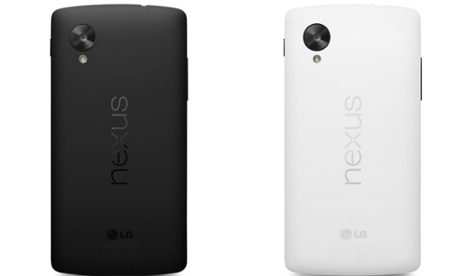
As with previous generations of Nexus smartphones, the Nexus 5 is based on pre-existing internal hardware from LG – in this case the LG G2. That’s a good thing, as the LG G2 is a superb phone hampered with poor software integration, something Google can completely iron out with its Nexus line of phones.
The Nexus 5 is, as the name might suggest, a 5in phone. It is a relatively small 5in phone, however, as there is barely any bezel around the screen’s left and righthand sides. The bezel above and below the screen is about one little finger’s width, and holds the speaker, front-facing camera and ambient light sensors up top, with the notification LED at the bottom.
It is worth noting that a 5in phone is quite hard to use one-handed if you have small hands. With my average-sized hands, I can more or less reach every corner of the screen with my thumb, but it can be a bit of a stretch. It is a trade off for a large screen, but for those moving from a 3.5 or 4in phone like the iPhone 5, it certainly takes some adjustment.
The phone looks rather understated and plain in black – not something that is necessarily bad – although a white model is also available. Short of the glass front, the rest of the phone is coated in a soft-touch plastic, which feels almost silky in texture and provides a good balance between being smooth and having enough friction to stop the phone sliding out of your hand.
A rounded back to the phone also feels very nice in the palm of your hand, while the light 130g weight makes the phone easy to hold one-handed. For comparison, the similarly shaped HTC One weighs 143g, while the Samsung Galaxy S4 weighs 130g, and the smaller iPhone 5S 112g.
Short of the Nexus logo, a small rear camera bulge in the top left-hand corner is the only feature of note on the back. It means the phone rests on it when laid down flat, which is an odd choice giving it little to no protection.
The front of the device is dominated by the 4.95in screen. It is a pin-sharp full HD IPS Plus LCD display, which means text on websites and ebooks looks crisp and easily legible, with photos and videos looking detailed and colourful. The screen is also very bright, making it much easier to read in direct sunlight than some competing screens on other devices.
Specifications
Fast and future proofed
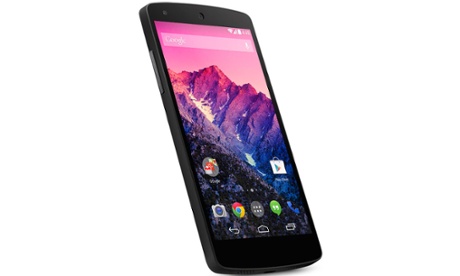
Google’s made sure that the Nexus 5 is as future-proofed as possible going forward with a top of the line processor in the form of the 2.3GHz quad-core Snapdragon 800 backed by 2GB of RAM. Combined with Google’s bloat-free version of Android, that makes the Nexus 5 the fastest phone out there at the moment.
Apps load instantly, games fly and nothing fazes the phone at all. In fact, it is actually possible to notice a small speed difference between the Nexus 5 and the already very fast HTC One or Samsung Galaxy S4 in general usage, which is truly saying something.
With 2GB of RAM and Android 4.4 Kitkat’s reduced memory requirements, multitasking is as fast as is possible with Android, meaning the Nexus 5 will handle anything you are likely to throw at it.
Google has also included LTE 4G that will work on any of the UK 4G networks, an improvement over the Nexus 4 which was limited to 3G, meaning downloads and page loads can be lightning quick if you have a 4G phone contract. It is worth noting that the Nexus 5 holds a 4G signal better than quite a lot of other smartphones currently available, suggesting its signal reception is solid most of the time, even in the dense signal black spots of London.
As with previous generations of Nexus devices, Google hasn’t included a micro SD slot for storage expansion. Here that means it is advisable to plonk for the slightly more expensive 32GB version, if your budget will stretch to it, as 16GB could be a tight squeeze once you’ve loaded up your apps, movies, music and games.
With all that powerful hardware under the hood, the battery life suffers slightly. The Nexus 5 will last most of a solid working day with enough battery left to get you home. Around two hours of web browsing, emails coming in all day and music playback over Bluetooth for about two hours, the battery typically ran flat by about 8pm at night. In comparison, the Sony Xperia Z1 typically lasts until around midnight under the same working conditions, and the iPhone 5 till around 10pm.
If you start to play games, that battery life decreases, but the Nexus 5 is about on par with some other top-of-the-line Android phones.
One negative thing that should be noted is that the volume of the internal speaker within the Nexus 5 is really quite low. As a result, it can be hard to hear your phone ring when in noisy environments. The Bluetooth audio volume output is also relatively quiet, which mainly affects connections to audio systems like a Hi-Fi or a car stereo rather than Bluetooth headphones.
Android the way Google intended
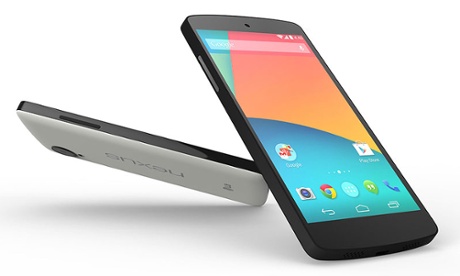
Google’s influence on the hardware is obvious, but it is with the software that it really excels.
The Nexus 5 runs the latest version of Android 4.4 “Kitkat”, which no other device currently operates, with full access to the Google Play store and its 850,000 standard Android apps. Not only is the Nexus 5’s operating system the latest and greatest, but it is also completely bloat free. This is Android as Google intends it, and the result is a very fast, fluid and lag-free experience.
There have been a few key changes in Kitkat over the previous version of Android called Jelly Bean – the most notable is the progressive integration of Google Now.
Google Now is Google’s intelligent personal digital assistant. It plugs into your Google account, pulling information from your Gmail, calendar, contacts, searches and mapping activities, preempting your requests for information with helpful suggestions.
For instance, Google Now will tell you when you need to leave to get to your next appointment, whether your commute will be delayed by traffic or congestion, and what the score is in the game one of your favourite teams is playing in.
In Kitkat, Google Now has moved from being hidden under the home button to a dedicated screen right on the homescreen. A swipe to the right reveals Google Now, but Google’s search can also be activated from any home screen by tapping in the search box at the top of the screen or by simply speaking the words “OK Google”.
The trigger words, inspired by Google Glass’ “OK Glass”, bring up the voice search box and allow you to search or ask a question immediately without having to press any buttons. The screen has to be on the homescreen to activate the search with the keywords, so it doesn’t actually save much time in practice. Your language also needs to be set to US English within Android – not UK English as is the default in the UK – for it to work currently.
One curious software quirk is that the Android back button will not return the user to the homescreen from Google Now, as it is actually a homescreen in and of itself – a small but irritating inconsistency with the rest of the Android experience.
Bizarrely, there are also now two Google photo applications installed by default, which perform essentially the same function - "Photos" and "Gallery". One is the new Google+ integrated photo application, and the other is the traditional photo album. Both do their respective jobs fine, but as with the back button and Google Now, they show Google's lack of single-minded focus and consistency when it comes to the user experience in some places.
Most of the other important software changes of Kitkat have been covered before, but it is worth noting that the new full-screen view, which hides the menu bar at the bottom and the notification bar at the top of the screen really works very well at maximising the screen space when reading or viewing content.
The integration of text messages into Google’s Hangouts chat app, also works great if you are a Hangouts user, and will tell you if your contacts are available on Hangouts or simply via SMS when you first try and send them a message.
Another nice addition is the inclusion of Google-aware caller ID, which scans the internet for names or businesses numbers that aren't in your address book. For instance, when the gas man rings to book a gas safety inspection, the phone app will search for the number and bring up the company's name automatically – a great feature, especially if you happen to screen calls from unknown numbers.
Camera, optically stabilised
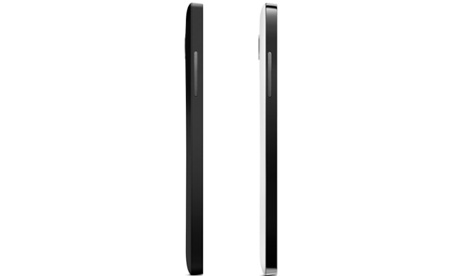
The camera is one thing that has suffered at the hands of the aggressive pricing of previous Nexus smartphones, but thankfully the Nexus 5’s camera is a notable step up.
It is 8-megapixels and packs optical image stabilisation (OIS), which helps smooth out hand shake and makes photos crisper. It is particularly noticeable when shooting video, as all the little jerks and movements normally inflicted on video when shooting hand-held are greatly diminished.
The high dynamic range (HDR) function, which takes multiple shots at different exposures and blends them into one image, is particularly good on the Nexus 5, producing greatly improved detail and colours in photos while staying just as pin-sharp as a standard photo thanks to the OIS.
Priced to undercut the competition
One of the best things about the Nexus 5 is its price. It costs £299 for the 16GB variant and £339 for the 32GB storage option directly from the Google Play store without a mobile phone contract. For comparison, the competition costs considerably more, with the Samsung Galaxy S4 priced at around £400, the HTC One £480, the Sony Xperia Z1 around £500 and the iPhone 5S at £549.
Verdict: the best value premium smartphone by miles
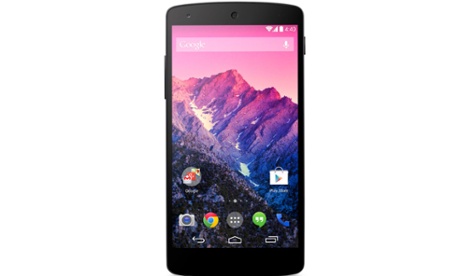
The Nexus 5 runs Android the way Google intended, which coupled with solid, fast hardware makes for a very compelling smartphone experience. It is as close as Android is ever going to get to the Apple’s model of doing things, where one company makes both hardware and software, and makes a better product in the process.
Its 5in screen is great, sharp and clear, its camera is decent, and the uncluttered, bloat-free Android Kitkat experience is refreshing. It is also future proofed, and is ensured rapid software updates direct from Google, which will help keep it feeling fresh and up-to-date going forward – something that can’t be overlooked when compared to its Android competitors.
Without a contract and for the price, there is no better value smartphone available at the moment across the iPhone, Android or Windows Phone. When bought with a contract, and therefore the price differences made more or less irrelevant, the decision is slightly less clear, but the Nexus 5 still holds its own.
Unless you want a bigger phone than 5in, or perhaps a slightly better camera and battery life, or expandable storage, the Nexus 5 is the Android phone to buy right now.
Star rating: 5/5

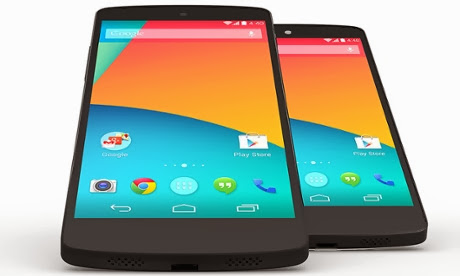
No comments:
Post a Comment